|

by Rob Waugh
10 May 2012
from TheDailyMail Website
|
New Excavation Reveals
Secrets of Their Calendar Including Black-Clad Figures
and Symbols Never Seen Before |
-
Wall covered in calculations
relating to Mayan calendar
-
Line-up of men in black
uniforms
-
Astrological calculations
not fully understood
-
Dates seem to stretch 7,000
years into FUTURE
-
Contradicts 'doomsday'
predictions about
2012
-
First paintings found on
walls in Mayan dwellings
-
Huge city in Guatemala
finally reveals its secrets
A vast city built by the ancient Mayan
civilization and discovered nearly a century ago in modern day
Guatemala is finally starting to yield its secrets - including a
hint that apocalyptic predictions around the 'end' of the Mayan
Calendar may be wrong.
Excavating for the first time in the sprawling complex of Xultzn in
Guatemala's Peten region, archaeologists have uncovered a structure
that contains what appears to be a work space for the town's scribe.
Its walls are adorned with unique paintings - one depicting a
line-up of men in black uniforms, and hundreds of scrawled numbers -
many calculations relating to the Mayan calendar, and stretching up
to 7,000 years into the future.
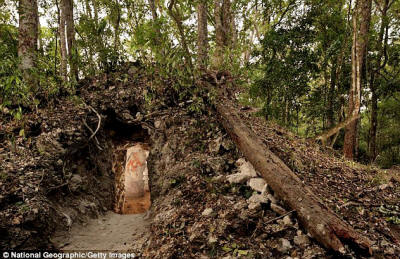
The painted figure of a man - possibly a scribe - is
illuminated in the doorway of the Mayan dwelling,
which holds symbols never seen before
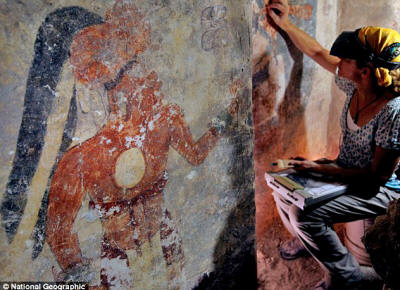
Angelyn Bass cleans and stabilizes the surface of a
wall of a Maya house that dates to the 9th century
A.D. A mysterious figure is shown painted on the
wall in the foreground
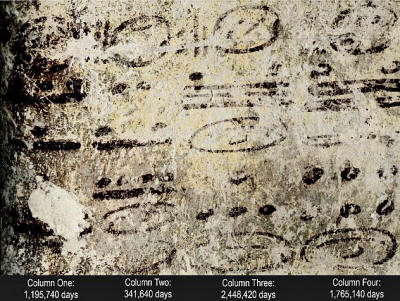
Four long numbers on the north wall of the ruined
house relate to the Maya calendar and computations
about the moon, sun and possibly Venus and Mars; the
dates may stretch some 7,000 years into the future.
These are the first calculations Maya archaeologists
have found that seem to tabulate all of these cycles
in this way.
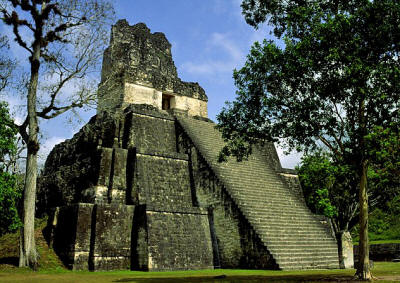
Mayan temples in Guatemala: Researchers have found
walls adorned with unique paintings - one depicting
a line-up of men in black uniforms, and hundreds of
scrawled numbers - many calculations relating to the
Mayan calendar
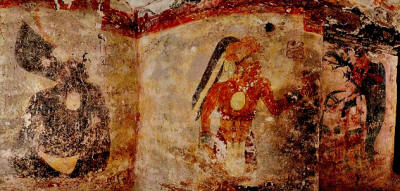
Never-before-seen artwork - the first to be found on
walls of a Maya house - adorn the dwelling in the
ruined city of Xultún
The excavations, which were funded by National Geographic, have
already revealed details about the Mayan calendar and the lives of
the inhabitants which were previously unknown.
One wall of the structure, thought to be a house, is covered with
tiny, millimeter-thick, red and black glyphs unlike any seen before
at other Mayan sites.
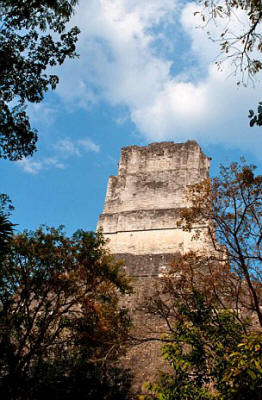
The Mayan sites in
Guatemala
have been
investigated by scientists since the Seventies
Some appear to represent the various
calendrical cycles charted by the Mayans - the 260-day ceremonial
calendar, the 365-day solar calendar, the 584-day cycle of the
planet Venus and the 780-day cycle of Mars.
Four long numbers on the north wall of the ruined house relate to
the Maya calendar and computations about the moon, sun and possibly
Venus and Mars; the dates may stretch some 7,000 years into the
future.
‘Why would they go into those
numbers if the world is going to come to an end this year?’
observed Anthony Aveni of Colgate University in Hamilton, N.Y.,
an expert on Mayan astronomy. ‘You could say a number that big
at least suggests that time marches on.’
These are the first calculations Maya
archaeologists have found that seem to tabulate all of these cycles
in this way.
Although they all involve common multiples of key calendrical and
astronomical cycles, the exact significance of these particular
spans of time is not known.
Archaeologist William Saturno, of Boston University in the
United States who led the exploration and excavation, said:
‘For the first time we get to see
what may be actual records kept by a scribe, whose job was to be
official record keeper. ‘It's like an episode of TV's 'Big Bang
Theory,' a geek math problem and they're painting it on the
wall. They seem to be using it like a blackboard.’
The scientists say that despite popular
belief, there is no sign that the Mayan calendar - or the world -
was to end in the year 2012, just one of its calendar cycles.
Anthony Aveni, professor of astronomy and anthropology at
Colgate University, said:
‘It's like the odometer of a car,
with the Maya calendar rolling over from the 120,000s to
130,000. ‘The car gets a step closer to the junkyard as the
numbers turn over; the Maya just start over.’
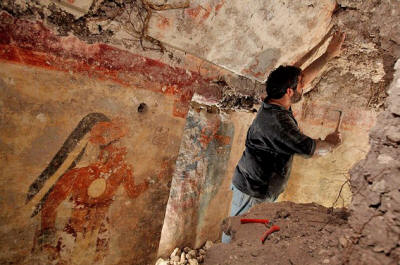
Archaeologist William
Saturno of Boston University
carefully uncovers
art and writings left by the Maya some 1,200 years ago
|
DO THE MAYANS PREDICT
THE WORLD WILL END IN 2012?
Inscriptions on Mayan tablets found in temples such as
Tortuguero refer to 'the end' - and many internet
conspiracy theories have predicted our world will be
swallowed by a black hole, hit by an asteroid or
devoured by ancient gods.
But many ethnic Mayans dismiss the apocalyptic
predictions
as largely a Western idea.
Rather than the end of time itself, the inscriptions
refer to the start of a new
era.
The 'apocalypse' refers to the end of a cycle of 5,125
years since the beginning of the
Mayan Long Count calendar in
3113 B.C.
|
The paintings represent the first Maya art to be found on the walls
of a house.
The walls reveal the oldest known astronomical tables from the Maya.
Scientists already knew they must have been keeping such records at
that time, but until now the oldest known examples dated from about
600 years later.
Astronomical records were key to the Mayan calendar, which has
gotten some attention recently because of doomsday warnings that it
predicts the end of the world this December.
Experts say it makes no such prediction. The new finding provides a
bit of backup: The calculations include a time span longer than
6,000 years that could extend well beyond 2012.
Aveni, along with William Saturno of Boston University and others,
report the discovery in Friday's issue of the journal Science.
The room, a bit bigger than 6-feet square, is part of a large
complex of Mayan ruins in the rain forest at Xultun in northeastern
Guatemala. The walls also contain portraits of a seated king and
some other figures, but it's clear those have no connection to the
astronomical writings, the scientists said.
One wall contains a calendar based on phases of the moon, covering
about 13 years. The researchers said they think it might have been
used to keep track of which deity was overseeing the moon at
particular times.
Aveni said it would allow scribes to predict the appearance of a
full moon years in advance, for example.
Such record-keeping was key to Mayan
astrology and rituals, and maybe would be used to advise the king on
when to go to war or how good this year's crops would be, he said.
‘What you have here is astronomy
driven by religion,’ he said.
On an adjacent wall are numbers
indicating four time spans from roughly 935 to 6,700 years.
It's not clear what they represent, but
maybe the scribes were doing calculations that combined observations
from important astronomical events like the movements of Mars, Venus
and the moon, the researchers said.
Why bother to do that? Maybe the scribes were,
‘geeks... who just got carried away
with doing these kinds of computations and calculations, and
probably did them far beyond the needs of ordinary society,’
Aveni suggested.
Experts unconnected with the discovery
said it was a significant advance.
‘It's really a wonderful surprise,’ said Simon Martin, co-curator of
an exhibit about the Mayan calendar at the University of
Pennsylvania Museum of Archaeology and Anthropology.
While the results of the scribes' work were known from carvings on
monuments,
‘we've never really been able to
identify a working space, or how they actually went about
things,’ Martin said.
The new work gives insight into that, he
said, and the fact the room had a stone roof rather than thatching
supports previous indications that the scribes enjoyed a high social
standing.
‘It's a very important discovery.
We're only getting a glimpse of it’ in the published paper, said
John B. Carlson, director of the Center for Archaeoastronomy in
College Park, Md.
‘This is an intriguing start for this discovery.’
Xultzn, a 12 square mile site where tens
of thousands once lived, was first discovered about 100 years ago by
Guatemalan workers and roughly mapped in the 1920s by
Sylvanus
Morley, who named the site ‘Xultzn’ - ‘end stone.’
Scientists from Harvard University mapped more of the site in the
1970s.
The house discovered by Prof Saturno's team was numbered 54 of 56
structures counted and mapped at that time. Thousands at Xultzn
remain uncounted. The team's excavations reveal that monumental
construction at Xultzn began in the first centuries B.C.
The site thrived until the end of the Classic Maya period; the
site's last carved monument dates to around 890 A.D.
Prof Saturno said:
‘It's weird that the Xultzn finds
exist at all. Such writings and artwork on walls don't preserve
well in the Maya lowlands, especially in a house buried only a
meter below the surface.’
Prof Aveni added:
‘The most exciting point is that we
now see that the Maya were making such computations hundreds of
years - and in places other than books - before they recorded
them in the Codices.’
The findings were reported in National
Geographic magazine and in the journal Science.
Mysterious Maya Calendar & Mural Uncovered
|







